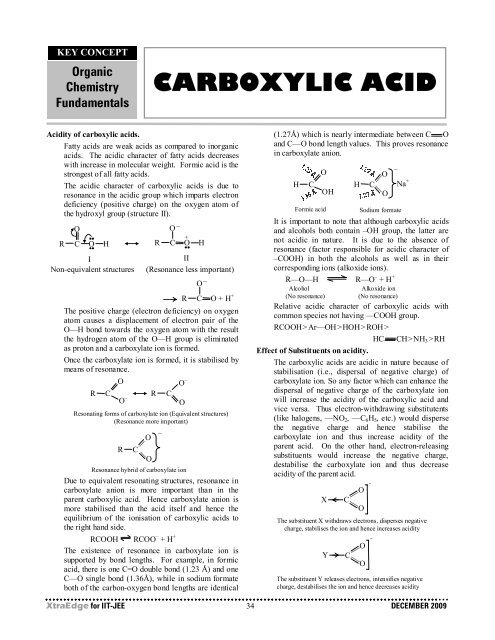Create successful ePaper yourself
Turn your PDF publications into a flip-book with our unique Google optimized e-Paper software.
KEY CONCEPT<br />
Organic<br />
Chemistry<br />
Fundamentals<br />
CARBOXYLIC ACID<br />
Acidity of carboxylic acids.<br />
Fatty acids are weak acids as compared to inorganic<br />
acids. The acidic character of fatty acids decreases<br />
with increase in molecular weight. Formic acid is the<br />
strongest of all fatty acids.<br />
The acidic character of carboxylic acids is due to<br />
resonance in the acidic group which imparts electron<br />
deficiency (positive charge) on the oxygen atom of<br />
the hydroxyl group (structure II).<br />
O<br />
R C O H<br />
I<br />
Non-equivalent structures<br />
O –<br />
R C<br />
+<br />
O H<br />
II<br />
(Resonance less important)<br />
O –<br />
R C O + H +<br />
The positive charge (electron deficiency) on oxygen<br />
atom causes a displacement of electron pair of the<br />
O—H bond towards the oxygen atom with the result<br />
the hydrogen atom of the O—H group is eliminated<br />
as proton and a carboxylate ion is formed.<br />
Once the carboxylate ion is formed, it is stabilised by<br />
means of resonance.<br />
O<br />
O –<br />
R C<br />
R C<br />
O – O<br />
Resonating forms of carboxylate ion (Equivalent structures)<br />
(Resonance more important)<br />
R<br />
C<br />
O<br />
O<br />
Resonance hybrid of carboxylate ion<br />
Due to equivalent resonating structures, resonance in<br />
carboxylate anion is more important than in the<br />
parent carboxylic acid. Hence carboxylate anion is<br />
more stabilised than the acid itself and hence the<br />
equilibrium of the ionisation of carboxylic acids to<br />
the right hand side.<br />
RCOOH RCOO – + H +<br />
The existence of resonance in carboxylate ion is<br />
supported by bond lengths. For example, in formic<br />
acid, there is one C=O double bond (1.23 Å) and one<br />
C—O single bond (1.36Å), while in sodium formate<br />
both of the carbon-oxygen bond lengths are identical<br />
–<br />
(1.27Å) which is nearly intermediate between C O<br />
and C—O bond length values. This proves resonance<br />
in carboxylate anion.<br />
H<br />
C<br />
O<br />
Formic acid<br />
OH<br />
H<br />
C<br />
O<br />
O<br />
–<br />
Sodium formate<br />
Na +<br />
It is important to note that although carboxylic acids<br />
and alcohols both contain –OH group, the latter are<br />
not acidic in nature. It is due to the absence of<br />
resonance (factor responsible for acidic character of<br />
–COOH) in both the alcohols as well as in their<br />
corresponding ions (alkoxide ions).<br />
R—O—H R—O – + H +<br />
Alcohol<br />
Alkoxide ion<br />
(No resonance)<br />
(No resonance)<br />
Relative acidic character of carboxylic acids with<br />
common species not having —COOH group.<br />
RCOOH > Ar—OH > HOH > ROH ><br />
HC CH > NH 3 > RH<br />
Effect of Substituents on acidity.<br />
The carboxylic acids are acidic in nature because of<br />
stabilisation (i.e., dispersal of negative charge) of<br />
carboxylate ion. So any factor which can enhance the<br />
dispersal of negative charge of the carboxylate ion<br />
will increase the acidity of the carboxylic acid and<br />
vice versa. Thus electron-withdrawing substitutents<br />
(like halogens, —NO 2 , —C 6 H 5 , etc.) would disperse<br />
the negative charge and hence stabilise the<br />
carboxylate ion and thus increase acidity of the<br />
parent acid. On the other hand, electron-releasing<br />
substituents would increase the negative charge,<br />
destabilise the carboxylate ion and thus decrease<br />
acidity of the parent acid.<br />
X<br />
C<br />
The substituent X withdraws electrons, disperses negative<br />
charge, stabilises the ion and hence increases acidity<br />
–<br />
O<br />
Y C<br />
O<br />
The substituent Y releases electrons, intensifies negative<br />
charge, destabilises the ion and hence decreases acidity<br />
O<br />
O<br />
–<br />
XtraEdge for <strong>IIT</strong>-<strong>JEE</strong> 34 DECEMBER 2009

















